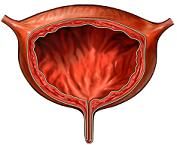BLADDER
Latin is the language from which the term bladder comes, etymologically speaking, which we are now going to analyze in depth. In this sense, we can say that it emanates from the word vesica , which in turn is based on a root of Indo-European origin.

The bladder is the organ that receives urine from the ureters and expels it out of the body through the urethra. This muscular and membranous organ is part of the urinary system of all mammals and acts as a kind of bag to store the urine produced by the kidneys.
The normal physiological capacity of the bladder ranges from 300 to 350 cubic centimeters. From this amount, the desire to urinate arises. When there is retention of urine , the capacity can increase to about 3 liters while, in cases of cystitis , it barely reaches 50 cubic centimeters.
The bladder wall is made up of three layers: the serous layer (formed by the parietal peritoneum), the muscular layer (with a smooth muscle that contracts during the expulsion of urine), and the mucous layer (which has an epithelium of urinary transition and a sheet of connective tissue).
The bladder neck, trigone, bladder dome or apex are other of the most important interior parts of the bladder where there are also veins, nerves, lymphatics and arteries.
The cystoscopy provides the appropriate method for the analysis of the bladder. It is an endoscopic examination that involves the introduction of a tube with a video camera through the urethral meatus, allowing the doctor to observe the urethra and bladder.
Among the most common diseases that occur in the human body and that affect the aforementioned bladder we would have to highlight, for example, cystitis. This is an inflammation, both temporary and chronic, the kind that produces fever, severe pain, a greater number of urinations and also weakness.
However, more pathologies that affect this part of the body are incontinence, which would be the loss of absolute bladder control, and bladder cancer. The frequent consumption of tobacco or coffee as well as certain chemical products, various drugs or radiation in the pelvic area are other causes that originate this last serious disease.
According to studies carried out by healthcare professionals, this severe pathology tends to affect men more than women and has increased alarmingly in recent decades.
It should be noted that bladder trauma from violent blows or stab wounds can be very serious and lead to death. Other bladder injuries arise for non-violent reasons, such as having a cesarean section or chronic alcoholism. An injury to a full bladder can cause urine to leak into the abdomen , causing peritonitis .
In addition to all the above, we cannot ignore the existence of what is known as a swim bladder. It is a membrane that different species of fish have and that helps them to stay between two types of waters without the need for great efforts.
Comments
Post a Comment